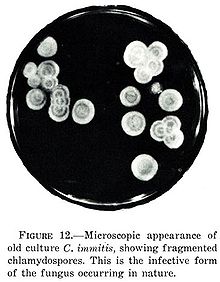| Coccidioides | |
|---|---|

| |
| Coccidioides immitis | |
| Scientific classification | |
| Domain: | Eukaryota |
| Kingdom: | Fungi |
| Division: | Ascomycota |
| Class: | Eurotiomycetes |
| Order: | Onygenales |
| Family: | Onygenaceae |
| Genus: | Coccidioides G.W.Stiles (1896)[1] |
| Type species | |
| Coccidioides immitis G.W.Stiles (1896)
| |
| Species | |
|
C. esteriformis | |
Coccidioides is a genus of dimorphic ascomycetes in the family Onygenaceae. Member species are the cause of coccidioidomycosis, also known as San Joaquin Valley fever, an infectious fungal disease largely confined to the Western Hemisphere and endemic in the Southwestern United States.[2] The host acquires the disease by respiratory inhalation of spores disseminated in their natural habitat. The causative agents of coccidioidomycosis are Coccidioides immitis and Coccidioides posadasii. Both C. immitis and C. posadasii are indistinguishable during laboratory testing and commonly referred in literature as Coccidioides.[3]
- ^ Cite error: The named reference
Rixford 1896was invoked but never defined (see the help page). - ^ "Coccidioidomycosis (Valley Fever)". Centers for Disease Control and Prevention (CDC). Archived from the original on 9 July 2013. Retrieved 11 July 2013.
- ^ Fauci, Anthony S. Harrison's Principles of Internal Medicine. New York: McGraw-Hill Medical, 2008.